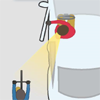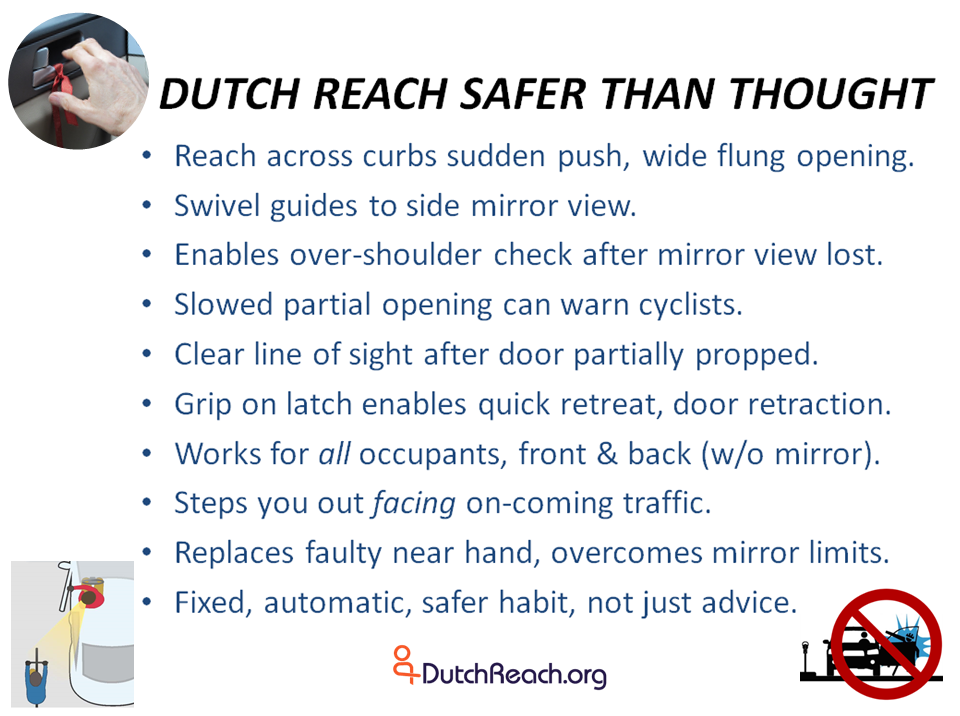Debating the Dutch Reach with Cycling Savvy Adherents
Note: The following Open Letter responds to criticisms leveled by several members of the California Association of Bicycling Organization (CABO) Forum listserv, many of whom adhere to Cycling Savvy &/or Vehicular Bicycling tenets. Their opinions appear in the thread entitled "Dutch Reach Fail" (March 2020).
Similar criticisms were debated in the posts and comment sections of John S. Allen's Bicycle Blog: The "Dutch Reach" (Feb 3, 2017), and John Schubert's Cycling Savvy Blog: The Real Door Zone Tragedy (May 2, 2018). In these, the Dutch Reach Project's founder responded in the comment sections.
Response to Criticism & Complaints re: 'Dutch Reach'
"Dutch Reach Fail" - Hardly.
Dear CABO Forum Listserv Members,
Thank you for your efforts to improve road safety for vulnerable road users. Also, thank you for exploring real and imagined consequences of adding a ‘Dutch Reach’ advisory to the California Driver Handbook.
Please consider the following clarifications:
1. SAFE EGRESS WITH REACH EXPLAINED: The most detailed presentation and examination of safe egress for motorists/passengers is at DutchReach.org>Menu Bar>Working Papers > Officials’ Dutch Reach Instruction Guide. If you are serious about discussing its merits or flaws, please study it. Note: This elaborate account is to provide detail & clarity for professionals & for skeptics like yourselves. Thank you for testing it.
2. MOTORIST NEGLIGENCE: Doorings are a significant problem in many cities across the globe. According to recent surveys of motorists in Germany, UK & Florida, 13%, 35% & 59.5% respectively admit to NOT checking at all before opening. No doubt many California drivers are are routinely negligent on egress as well. But why? As doorings are common & side view mirrors are universal, what could be going wrong? Of course motorists are too often lazy, poorly trained and indifferent to risk imposed on others. They act habitually and heedlessly. But note, the Near Hand Habit is all but universal in the US. It does not habituate side mirror use. It discourages shoulder checking. And it enables sudden wide door shoves which ambush cyclists. The Dutch people swapped hands 50 years ago as they found that the Far Hand Hand habit was far safer. It induces side mirror use, pivots to ease an over-the-shoulder check, and curbs door fling. Some prominent members of the Forum doubt these advantages. Yet numerous respected road safety professionals & organizations find otherwise.
3. MOTORIST RESPONSIBILITY: Regardless of choices or actions taken by vulnerable road users (VRU’s), driver negligence is a major factor in egress related incidents and most states now deem such obstruction illegal.
4. NEAR HAND HABIT IS FAILURE PRONE: Multiple independent international road safety experts now consider the Dutch habit is an improvement over the ‘grandfathered’ Near Hand Habit with its record of negligent execution including failure to consult the side mirror and its tendency to allow a near hand to push, shove or fling open the door, ambushing cyclists without warning. It also limits torso rotation & a proper over the shoulder check etc. The Dutch habit’s multiple safety advantages are detailed in the Officials’ Dutch Reach Instruction Guide. The most significant are listed in the 'Safer than Thought' slide here.
5. ON FLINGING: The Far Hand Method as demonstrated by the Dutch driving instructor here, and as described in the Guide 7.c., includes retaining hands on the door latch & arm rest so as (in windy Holland) prevent a gust from blowing it open. This also prevents sudden wide flinging entirely.
6. MIRROR USE: Let’s be clear: For drivers & front seat passengers consulting the side view (aka wing mirror) is very valuable although it has limitations (See Guide #7.e.). The far hand habit as opposed to the near hand habit turns the user to view the mirror. Of course the wing mirror should be used and many drivers consider it sufficient. So be it if they must. But the clear safety gain will occur should novice drivers be entrained to use the far hand habit from the get-go. Additional gains will accrue by attempts to retrain the 30-60% of motorists who are now habitually heedless. Also passengers need to be retrained. To this end, he the Dutch Reach campaign has already influenced Uber internationally, Lyft domestically, MODO in Vancouver Ca & Addison Lee UK to promote the Dutch Reach to their TNC drivers & clients.
7. ON REAR PASSENGERS WITHOUT MIRROR ACCESS: Unless a vehicle has added B-pillar auxiliary mirrors, rear passengers must exit with greater care. Fortunately the Reach habit causes the occupant to swivel out and enables peripheral side and the over-the-shoulder view back followed by limited initial opening and a direct view back with continued door control when using the Reach. NOTE: Some CABO commenters are confused by the order of actions. Watch RoSPA video with a Dutch driving instructor demonstrate the mirror checks & the lean out shoulder check here. Also view the National Safety Council’s video here.
8. ADD TO DMV MANUALS & TEST (BUT NO MANDATE): Improving motorist/passenger training and actual practice can reduce negligent egress. Authorities & road safety advocates may accomplish this by a variety of means - and upgrading state driver’s manuals & driver licensing standards advances this effort. Note: No state or country, not even The Netherlands, “mandates” use of the far hand reach. Testing for licensure however leads driving instructors & novice students to teach & practice it. And ‘having it ‘on the books’ may strengthen compliance by threat of successful dooring prosecutions or lawsuits.
9. MANY PARTIAL SOLUTIONS: There is no one solution to doorings. Many measures reduce dooring risk and each are valuable. Every good solution has its limitations of implementation or practice. Well known measures include: No DZBL’s; Take the Lane aka No Edge Riding; Separated & Protected Bike lanes & Tracks; laws & enforcement against blocking bike & travel lanes; larger fines & penalties; insurance points; civil lawsuits & criminal prosecutions, education & outreach campaigns & programs, defensive driving courses; ADAS sensing, alerting, warning, & automatic-door-locking technologies; auxiliary B-pillar mirrors for rear passenger use; etc. See examples of Tech solutions here.
10. THE NAME: Until the Dutch Reach Project (DRP) in 2016, my coinage ‘Dutch Reach’ & promotion thereof, this 50+ year old (yes Dutch) safety tip has been little known outside of The Netherlands & perhaps Denmark. The first known English print description in mainstream media was in the New York Times in 2011. The Dutch Reach “brand” has since gained considerable name recognition. While not a necessity, Dutch Reach is what the method is now best known in the US and abroad. Outside Online magazine's video alone has been viewed over 3.2M times. Purely descriptive names may be preferred as they can be self explanatory and translate directly into other languages. So for the best of both worlds be descriptive in official materials but also call it the “so-called Dutch Reach” as several US states now do.
11. BY ANY OTHER ~ : Whether you call it the Far Hand Reach (NSC, 2019), Reach Across (NYC DOT, 2019), Opposite Hand Trick (BFD program (~2014), Cross Check (AUS), Lead with your Left (AUS), Amsterdam or Northern European method in New Haven CT, (2013), or Dutch Reach (RoSPA, AAA, So. Cal AA, CAA, MA, PA, WA); or the ‘No Name’ far hand habit: Victoria, Australia (2012), Montreal (2014), SFMTA & Vision Zero SF (2015), Vancouver (2016), The Netherlands (1961 on), etc., -- the technique should be judged on its merits.
12. SHORT vs DETAILED ? Each version of Reach presentation -- text, image, video - should be judged on how well it triggers, explains or motivates & thereby improves vigilance & caution upon egress. There is as yet - and likely never will be - an internationally approved egress directive. There will be diverse & often incomplete presentations by necessity or purpose. Due to the nature of media coverage, human imperfection & miscomprehension or lack of obsessive care, versions can be flawed or misleading. This includes versions on the wide open web & even by established & respected media outlets or authorities. The Dutch Reach Project has been collecting examples and evolving its own preferred versions - variously for stickers, for professionals, for home page, for popularization, etc. Since our founding, we too have tried to weed and find better ways to teach the Reach. If you can suggest better, please do.
13. DUTCH REACH 'ENDANGERMENT'?: Some Forum commenters speculate that increased Dutch Reach use will lead naive cyclists use DZBLs rather than take the lane. Frankly this seems a considerable stretch as John Forester points out as well. [By the way, this same logic might hold that ADAS dooring alert & warning technologies should also be opposed until they become fail-proof, universal standard features on all motor vehicles. Is it really your goal to deny all partial interim fixes while waiting for 'Take the Lane' to become universal practice? Also if, as some insist, that the Reach will never catch on in California - though it did in The Netherlands - why this fear?
Additional questions, comments, criticisms are welcome and I will do my best to respond asap.
Michael Charney
Dutch Reach Project
www.dutchreach.org
Cambridge, MA, USA
P.S. Dutch Reach Project is an entirely volunteer, self-funded, grassroots effort to popularize the far hand habit. For those in CABO who suspect a nefarious or self-serving motive behind this effort, not to worry, not true! Please visit About and scan the posts and lists of numerous altruistic contributors.
An Exchange re: Dutch Reach on Cycling Savvy Website
Near the end of Cycling Savvy (CS) instructor John Schubert's blog post The Real Door Zone Tragedy, (
Now it’s time to return to Mr. Trinh’s tragic [dooring] case and the blogosphere. The countermeasure that bloggers have most often suggested is something called the Dutch Reach. This is a campaign to get motorists to reach across the steering wheel with their right hand to open the car door. The belief is that this will naturally cause motorists to look out for overtaking door zone bicyclists.
But the belief is bogus. There are numerous problems with this so-called solution that I’ll expand on another time. In the words of one knowledgable [sic] Southern California activist, Nevram Norman, “I’ve tried the ‘Dutch reach.’ It doesn’t force me to look backwards, it just crosses my arms.”
As of this writing (March 30, 2020) Mr. Schubert has not published his afore promised treatise contra the Dutch Reach. However amid the 51 Comments appended to his blog, the Dutch Reach Project engaged Schubert and his like-minded colleagues regarding their criticisms. To find and read the debate use this link or search Schubert's blog for "Michael Charney" amid the Comments. An extended debate begins as follows:
Dear John Schubert,
You allege that the Dutch Reach is “bogus” & does not provide safety benefit to cyclists. I of course beg to differ ...
Simple Description
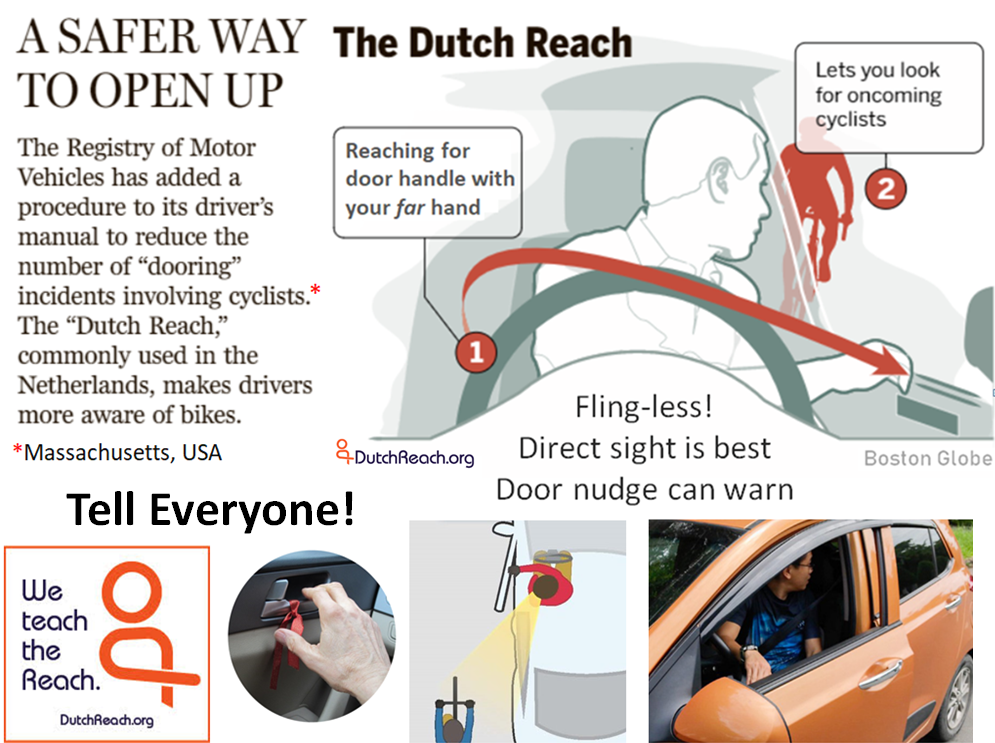
Dutch Reach diagram with montage. Boston Globe, 5/31/17. Click here for more versions. languages
Dutch Instructor Teaches Reach
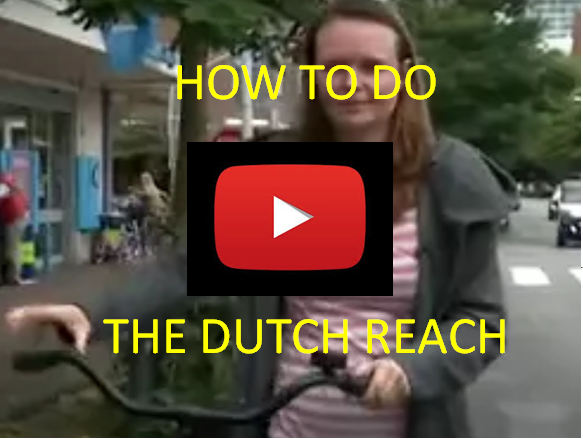 Produced by the Royal Society for the Prevention of Accidents (UK). View RoSPA advisory here.
Produced by the Royal Society for the Prevention of Accidents (UK). View RoSPA advisory here.
How do you get out of a car? - 1961 Signpost, De Telegraaf
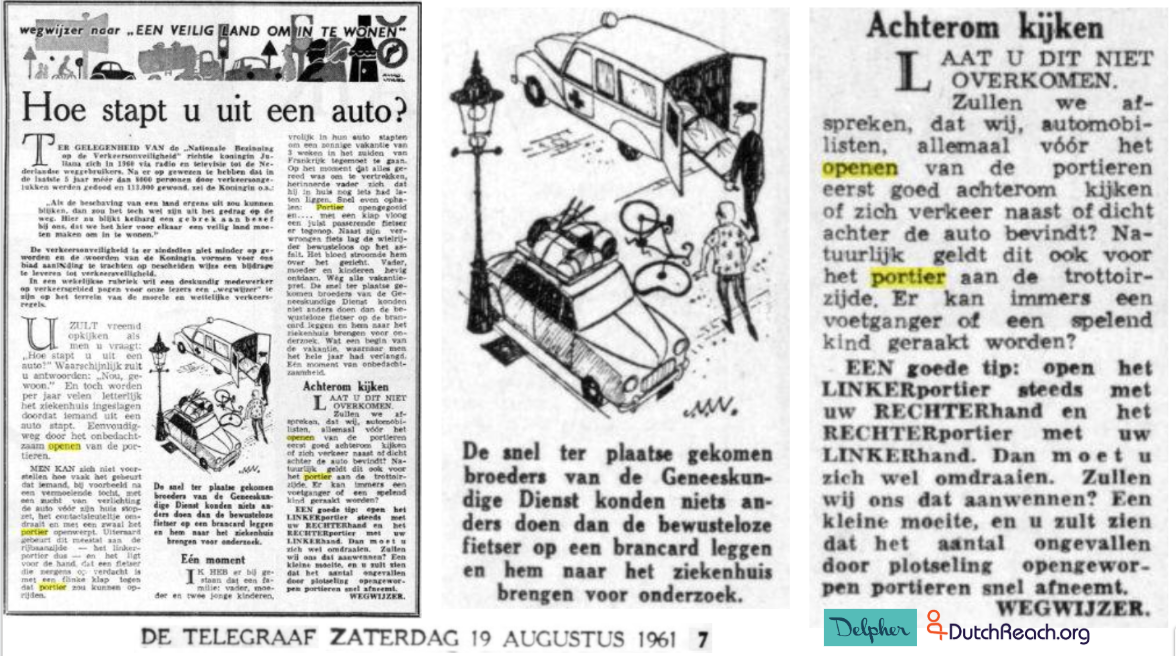
Hoe stapt u uit een auto? (How do you get out of an auto?) Wegwijzer / Signpost, De Telegraph, 19 Aug 1961, p. 7. Possibly the first Dutch account of the far hand aka 'Dutch Reach' method yet found, Article's translation & more about the Reach Habit's origins here. Click image to enlarge;
Adoption & Endorsements
 Loading...
Loading...
Significant Media Coverage
 Loading...
Loading...
Most Viewed Videos
